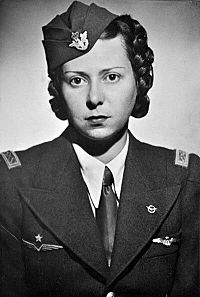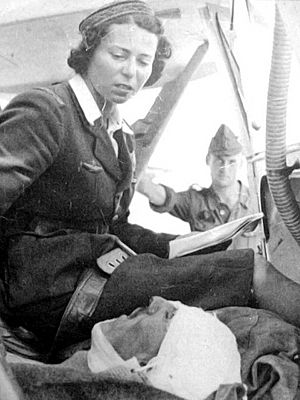Mariana Drăgescu facts for kids
Quick facts for kids
Mariana Drăgescu
|
|
|---|---|

Cmd.av. Mariana Drăgescu
(pictured, 2nd lt) |
|
| Born | 7 September 1912 Craiova, Kingdom of Romania |
| Died | 24 March 2013 (aged 100) Bucharest, Romania |
| Allegiance | |
| Service/ |
Romanian Air Force |
| Years of service | 1940–1955 |
| Rank | Comandor (OF-5) |
| Unit | White Squadron |
| Battles/wars | World War II
|
| Awards | Order of the Star of Romania, Order of Aeronautical Virtue, Order of the German Eagle |
Mariana Drăgescu (born September 7, 1912 – died March 24, 2013) was a brave Romanian military aviator during World War II. She was the last person alive from the famous White Squadron. This special team of women pilots flew planes to help wounded soldiers during the war. Romania was the only country that let women fly these important medical missions.
Contents
Early Life and Becoming a Pilot
Mariana Drăgescu was born in Craiova, Romania, on September 7, 1912. Her mother was a music teacher, and her father was a military officer. He became a colonel after World War I. Mariana first saw planes when she was only four years old. She was in Bucharest with her family when German planes bombed the city. She remembered hiding in a basement but still wanting to see the planes.
In 1935, when she was 23, Mariana earned her pilot's license. She was the seventh woman in Romania to become a licensed pilot.
Joining the White Squadron
As war became more likely in Europe, Mariana was asked to join a new, all-female flying team in 1938. This team became known as the White Squadron. The other four women who joined were Virginia Thomas, Nadia Russo, Marina Știrbei, and Irina Burnaia.
During the war, the White Squadron saved the lives of over 1,500 soldiers. These soldiers were injured on the front lines and needed urgent medical care.
Wartime Flying Missions
The White Squadron used small planes. These planes were painted white and had a red cross sign on their sides and wings. In June 1941, Romania joined the war against the Soviet Union. The squadron then began flying wounded soldiers from the battlefields to Bucharest for medical help.
Mariana explained that they would fly very low to the front lines. If there were no airports nearby, they were allowed to land anywhere. This was very dangerous.
Dangers in the Sky
Enemy planes sometimes hunted the white planes. However, the squadron's pilots flew very low, sometimes only 50 meters above the ground. This made it hard for enemy pilots to attack them in the air. But enemies would still target the planes once they landed. Because of this danger, the squadron's planes were repainted in camouflage colors after the first month of war.
Sometimes, the wounded soldiers were surprised to see young women pilots in white uniforms. Mariana remembered one soldier shouting, "John, an angel!" He thought he had died and was seeing heaven.
Mariana Drăgescu flew in many important battles. These included the Siege of Odessa, the Crimean campaign, and the Battle of Stalingrad. She was the only Romanian woman pilot left on the front lines after other pilots resigned or became ill.
After the War
After World War II ended, Mariana Drăgescu worked as a flight instructor. She taught flying at schools in Chitila and Ghimbav. She was allowed to fly until 1955, when her pilot's license was taken away. Later, she worked at a clinic in Bucharest until she retired in 1967.
During the time Romania was a communist country, the story of Romanian aviation and the White Squadron was not often told. After the Romanian Revolution of 1989, their brave actions finally received the recognition they deserved.
Mariana Drăgescu passed away in Bucharest on March 24, 2013. She was 100 years old.
Honors
- Knight of the Order of the Star of Romania
- Order of Aeronautical Virtue
- Order of the German Eagle


